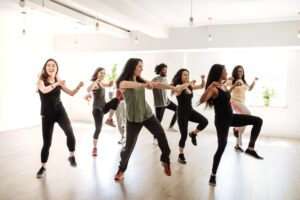Zumba is a popular and energetic fitness program that combines dance and aerobic exercises with Latin and international music. Created in the 1990s by Alberto “Beto” Perez, a Colombian dancer and choreographer, Zumba has gained worldwide popularity for its fun and effective approach to fitness.

Key Elements of Zumba
- Dance Styles: Zumba incorporates a mix of dance styles, including salsa, merengue, cumbia, reggaeton, and more. These dances are performed to the rhythm of lively, often high-energy music.
- Aerobic Exercise: Zumba classes typically include high-energy, aerobic movements such as jumping, squatting, twisting, and shuffling. These movements increase heart rate and contribute to cardiovascular fitness.
- Interval Training: Zumba often includes interval training, which alternates between high-intensity bursts of movement and lower-intensity recovery periods. This can help improve cardiovascular endurance and calorie burning.
- Core and Resistance Exercises: Some Zumba classes also incorporate core and resistance exercises to target specific muscle groups and improve overall strength and stability.
- Global Music: Zumba classes feature music from around the world, creating a dynamic and exciting atmosphere. The music is carefully selected to match the intensity of the dance routines.
Benefits of Zumba
- Cardiovascular Fitness: Zumba is an effective way to improve cardiovascular health by increasing heart rate and boosting endurance.
- Calorie Burning: The combination of dance and aerobic exercises in Zumba can help with weight management and calorie burning.
- Full-Body Workout: Zumba works various muscle groups, providing a full-body workout, especially targeting the core, legs, and glutes.
- Mood Boost: Zumba is known for its upbeat music and lively atmosphere, which can contribute to a positive mood and stress reduction.
- Social Interaction: Zumba classes are often conducted in groups, offering a social and supportive environment that can enhance motivation.
Types of Zumba Classes
- Zumba Fitness: The traditional Zumba class, combines Latin and international music with dance and aerobic movements.
- Zumba Toning: This version incorporates lightweight toning sticks or dumbbells to add resistance training elements to the dance routines.
- Aqua Zumba: Performed in a pool, Aqua Zumba is gentler on the joints and is suitable for individuals with mobility issues.
- Zumba Gold: Designed for older adults or beginners, Zumba Gold focuses on lower-intensity movements while maintaining the fun and dynamic aspect of Zumba.
- Zumbini: Geared toward babies and toddlers, Zumbini is a parent-child program that encourages movement and music engagement.
Considerations
- Fitness Level: Zumba is generally accessible to people of all fitness levels, as participants can modify movements to match their abilities.
- Apparel: Wear comfortable, breathable clothing and supportive athletic shoes.
- Hydration: Stay well-hydrated during Zumba classes, as the high-energy dance routines can be quite intense.
- Safety: Listen to your body, and don’t push yourself too hard. If you have any medical concerns, consult with your healthcare provider before starting a Zumba program.
Zumba is a fun and effective way to stay physically active and improve fitness while enjoying the rhythm of music and the camaraderie of a group setting.
It’s suitable for people of various ages and fitness levels, making it a great choice for those looking to enhance their cardiovascular health, coordination, and mood through dance and exercise.










